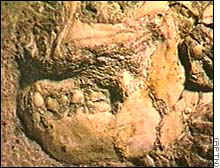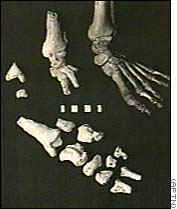|
||||||||||||||
|
|
"Just one bone would be exciting but this is apparently the whole skeleton -- the secret to knowing how the creature functioned. This eliminates any speculation," said Professor Phillip Tobias, who led the team of researchers from South Africa's University of the Witwatersrand (Wits). He told a news conference that the discovery was "probably the most momentous find ever made in Africa," and said it would aid the search for the missing link in man's evolution from ape to human. Past finds of ape-man fossils, including the oldest hominid bones, found in East Africa, have only been partial skulls or skeletons. "We're getting down nearer to the critical parting of the ways between apes and us -- perhaps 5 to 7 million years," Tobias said. Mislabled bones led to findThe discovery followed three years of work after Wits researcher Ron Clarke chanced on ankle and foot bones while looking in a box incorrectly labeled "animal bones." Clarke realized the bones belonged to the Australopithecus, a hominid which had both human and ape features.
Following up on the find, Clarke and his team discovered the remaining bones in university cupboards and by revisiting the cave in Sterkfontein where the ankle and foot bones were found. Much of the skeleton remains embedded in fossil rock at Sterkfontein. Clarke said the complete significance of the skeleton would not emerge until after it had been unearthed from a 15-meter-deep limestone shaft. "But what we do already know is that it will reveal a very great deal about the anatomy and evolution of an early ape- man," Clarke said. Preliminary evidence shows that the ape-man not only walked upright, but was also a tree climber, he said. Clarke's assistants, Nkwane Molefe and Stephen Motsumi, described how they had spent a year in the dark, wet cavern chipping away at the limestone after finding a few bones discarded by limestone workers. Clarke's findings appeared Wednesday in the South African Journal of Science and were due to be published Thursday in the journal Nature. He said there were signs of further hominid fossils at Sterkfontein, which the South African government has nominated to become a World Heritage site. The Associated Press and Reuters contributed to this report. |
|||||||||||||

